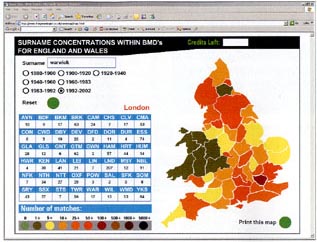with a number of software packages designed to look for anomalies in names and relationships. Parallel to that we started the volunteer site, www.ukindexer.co.uk, which allows volunteers to go through the census material as a final check.
“Volunteers are given a page or so of returns at a time. They will check the transcripts against the images and if they see something wrong with them then they flag them up. Another volunteer then checks their work. If there is any conflict between the two checks then one of our staff will look at it and will use additional resources – other years of census, directories or other records – to correct it.”
Case Study
I used TheGenealogist as I had hit a brick wall. I needed clarification for some information I had found on the 1851 census, so I visited the site to look at their 1841 material. I was thoroughly satisfied with their site – it was easy to use and I found what I was looking for straight away. I have recommended it to several of my friends and would definitely use it again.
Susan Britton, Lancashire |
Nigel prides his company on having developed the most accurate checking system out there. “We care about quality. We are unique in having such a barrage of checks, both in software and manually, to ensure that all the data we publish is as precise as we can be. We also have integrated reporting so if there are any problems then they can report them straight away online. We have full-time staff to deal with any problems.”
There are additional perks to using the site for census searching. Full
|

Follow the historical progress of your family name.
transcriptions of the records mean that the searches can be done on all fields, including occupation and relationship to head of household. The full transcriptions also mean that users have to look at fewer images than on other sites and can use the site easily without a broadband connection.
As well as the census results they publish a multitude of other records: all the BMDs for England and Wales, 1837 to 2004, the Philimore Parish records; some pre-1900 parish record transcripts and county records; a number of directories; and specialised indexed such as landowner records and the Knights of England (data from heraldry lists of 1127). Eventually they also plan to upload all the information they currently produce on CD.
As with the census checking, many of the other records get special treatment to ensure they are as accurate as possible. Nigel explained: “We have all the BMD indexes and they are as comprehensive as those on 1837online.com. More so, actually, as we found missing pages on the original microfilm and have gone back to the GRO and re-microfilmed and scanned the original books. We also re-photographed pages that were pages that were very yellow and difficult to read.”
The site also uses GRO databases for BMDs from 1984 onwards to allow users to perform ‘Smart Searches’. This intelligent facility allows users to pursue several additional lines of enquiry. They can search for all children born to a couple, if they specify father’s surname and mother’s maiden
|
name; see the details for either partner in a marriage; and find a birth record for a corresponding death record. A current project for staff at TheGenealogist is incorporating pre-1984 data into the same database, to allow similar searching of earlier records.
In addition to this, a new mapping software system on the site allows you to see where people with certain surnames were born and lived. “Certain names seem to spread over time from one area – or from ports when people enter the UK,” says Nigel. “It is also very interesting to see people move into London: in the 1841 census you can see that the population is quite low and the outskirts are quite rural but this soon changes. I believe this is one of the reasons why people are interested in family history – understanding something about your own family’s changing wealth and circumstance gives you a unique way of looking at history.”
Nigel’s Top Tips
- Find out where in the country your surname is concentrated by using the map feature within the BMDs or the 1851 census.
- Use the excellent new research guide to the site, written by Family History Monthly computer expert, David Tippey. Find it at www.thegenealogist.co.uk/researchguide/
- When searching the census, use the wildcard (*) after the first three letters to capture the widest range.
- Use surname and forename variants to make sure the spelling of a name, or the use of a common form of a name, like Bessie for Elizabeth, isn’t catching you out.
- With births, marriages and deaths remember to check the next quarter, in case of a late registration of the event.
- Use SmartSearch to find family members in the database records. It will give you all the children for a marriage, or allow you to look at a birth for a person using the info contained in a death record.
|
|